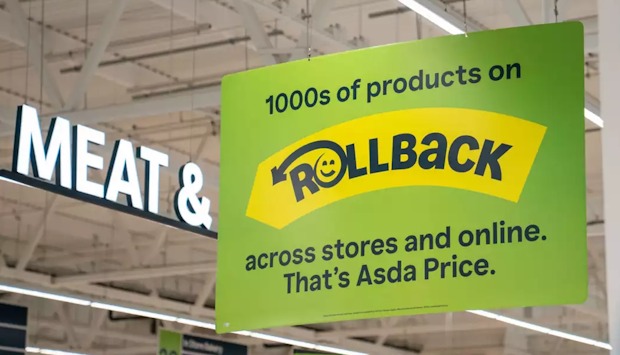Asda saw a marked improvement in performance during its second-quarter period to 30th June, as investment in lowering prices and improving product availability helped it win back shoppers and strengthen volumes.
 On a like-for-like basis, group sales declined by just 0.2%, compared to falls of 3.1% and 4.2% in the previous two quarters. The supermarket’s total revenue for Q2 (excl. fuel) decreased by 0.2% to £5.3bn.
On a like-for-like basis, group sales declined by just 0.2%, compared to falls of 3.1% and 4.2% in the previous two quarters. The supermarket’s total revenue for Q2 (excl. fuel) decreased by 0.2% to £5.3bn.
Asda noted that since launching its Rollback campaign in January, more than 50% of all products – approximately 14,000 SKUs – have been through or are currently undergoing the price reduction cycle, before being moved to a “new, permanently low Asda Price”. The retailer claimed that the average price reduction of these products is 22%, helping shield customers from rising food price inflation. It noted that its own inflation rate remains “significantly lower” than the 5% market average.
Meanwhile, Asda highlighted that it has made progress in improving product availability, with the current level standing at 96% – the highest in eight years.
In its George unit, like-for-like sales were up 2.5%, with its new standalone non-food concept store in Leeds, which is set to replace its Living brand, said to be performing well. Asda is planning to roll out a further 10 of the George stores across the UK next year.
Meanwhile, Asda claimed its Express chain was outperforming the wider convenience market with like-for-like sales growth of 8.6%. Earlier today, the company announced that it was resuming its Express store opening programme after a pause to focus on converting the 469 sites it acquired from the Co-op and EG Group.
Asda also revealed today that Project Future, the troubled IT programme to separate its systems from its former owner, Walmart, was now complete, with all stores, food depots, and office systems operating on its own technology.
Allan Leighton, Asda’s Executive Chairman, commented: “We saw a clear improvement in performance during Q2, with volumes and like-for-like sales strengthening, driven by better product availability and our material investment in price. This widened the price gap over competitors and firmly re-established Asda as the best-value traditional supermarket.
“As planned, we expect to exit the year in like-for-like growth as we continue our investment in price to protect our customers from inflationary pressures. As we’ve said from the outset, transforming Asda will take time, but we remain confident in the direction of travel and the long-term potential of the business.”
Leighton added that he still expected a “material reduction in profit” at the business this year as it intended to continue investing what he has called “a pretty significant war chest” in keeping prices down and putting more staff on the shop floor.
Michael Gleeson, Asda’s Chief Financial Officer, added: “These results are in line with our expectations as we made further progress on our journey. The completion of Project Future is an important moment, and we are beginning to benefit from operating in one world. We have seen like-for-like improvement over the last four quarters and expect to exit the year in like-for-like growth.”
NAM Implications:
- All the pieces are in place.
- All functioning to spec.
- Now a matter of time.
- (and stakeholder patience)
- As we await the impact on market share…



